
Pregnancy is the perfect time to begin or maintain a yoga practice. A pregnant woman can benefit immensely from yoga’s calming effects and preparative powers. Oftentimes, her health care provider will recommend yoga for her overall wellbeing, and she may visit a general hatha yoga class with an instructor may not be trained in prenatal yoga modifications. Though it is recommended that an expectant mother attend specialized prenatal yoga classes, general yoga asana classes can be made appropriate for pregnant students with a few basic, yet vital, modifications.
Two Types Of Pregnant Yoga Students
 It is beneficial to distinguish two types of prenatal students: those who have been practicing yoga consistently for a length of time prior to conception, and have continued to practice during their pregnancy, and those who are new to yoga, or are returning to yoga prenatally after a long absence.
It is beneficial to distinguish two types of prenatal students: those who have been practicing yoga consistently for a length of time prior to conception, and have continued to practice during their pregnancy, and those who are new to yoga, or are returning to yoga prenatally after a long absence.
It is important to take this variance into consideration when modifying their asana practice. I adjust the poses and alignment of established practitioners very little, outside of contraindication. A practiced yogi knows her body and her preferences on the mat.
As a rule, a seasoned yogi can maintain her regular practice as long as she feels comfortable, is free of pain, and is following the advice of her health care provider. Giving her the space to practice what comes naturally will allow her intuition to develop on the mat. She may derive her own prenatal modifications as her pregnancy progresses by sensing her body from within, a necessary skill for navigating the internal processes of childbirth.
Prenatal Yoga Modifications
The practice of a newcomer, or returning student, will need to be suited for her phase of pregnancy, whether is she is in the first trimester, and doesn’t look pregnant yet, or is in the full abundance of her final weeks of gestation. Generally, avoid overheating expectant students with rigorous Sun Salutes, vinyasas, or a warm room without proper ventilation.
Deter students with a baby bump from lying on their bellies, or flat on their backs, by offering different poses with similar outcomes, such as an easy Camel Pose instead of Locust Pose. Introduce alternatives to inversions, like legs-up-the-wall-pose with a bolster pillow under the spine to elevate the heart. It is important to keep all twisting positions very simple, wherein the front of the body can remain open by turning away from the legs, and not towards them. Finally, an ideal position for shavasana is lying on the left side with a blanket between the legs and another under the head.
Prenatal Alignments
Throughout pregnancy, both well practiced and beginner yoga students should implement the fundamentals of prenatal alignment. Beginning with the feet, the pregnant stance should always be hip’s distance apart, or a little wider, as opposed to toes touching. Standing with the feet hip’s distance apart distributes weight more evenly through the feet, supporting healthy foot arches, and providing room for the widening pelvis. The curve in the lower back becomes emphasized in pregnancy, which can result in the most common prenatal discomfort, lumbar lordosis. This results in the waddle often seen in the gaits of pregnant woman, and is associated with lower back pain and fatigue.
Encourage your pregnant student to turn their toes slightly inwards to mitigate this common symptom of pregnancy. In the beginning, she may feel pigeon-footed, but with practice, this stance will become the new norm, allowing her to lift up and out of her lower back. Turning the toes inward takes weight off the femoral heads, and alleviates stress in the sacroiliac joints and lower back. The wide legged, inward toed stance, paired with a slightly bent knee, lengthens the spine and supports a proper gait without the pregnancy waddle.
 Maintaining the aforementioned bend in the knees will greatly enhance mobility and flexibility in your prenatal students. Forward folds, when practiced with proper foot alignment and deeply bent knees, can be safely practiced during pregnancy, creating much needed length in the back of the body. Modified Sun Salutes can be practiced if the feet are in proper alignment and the knees are softened, as can squats, which prepares the legs and pelvic floor for the rigors of childbirth. Keeping the knees bent insures proper blood flow between the lower and upper regions of the body, and lessens the likelihood of sciatic nerve pain or lightheadedness.
Maintaining the aforementioned bend in the knees will greatly enhance mobility and flexibility in your prenatal students. Forward folds, when practiced with proper foot alignment and deeply bent knees, can be safely practiced during pregnancy, creating much needed length in the back of the body. Modified Sun Salutes can be practiced if the feet are in proper alignment and the knees are softened, as can squats, which prepares the legs and pelvic floor for the rigors of childbirth. Keeping the knees bent insures proper blood flow between the lower and upper regions of the body, and lessens the likelihood of sciatic nerve pain or lightheadedness.
Though the legs may be straight in some poses, such as trikonasana, Triangle Pose, your pregnant students should always be reminded to not lock their knees, instead keeping the joints softened, focusing more on widening and flattening the feet to stay grounded in the pose.
Allow prenatal students to release and relax after each segment of poses, whether she is standing, sitting, or reclining. Regular releases of the hips and shoulders, elbows and knees, wrists and ankles, should be implemented, along with full exhales through the mouth. Watch her face for tension, especially in her mouth, jaw, and brow, and encourage her to soften her expression.
By exhaling through the mouth, subtle tension is released from within, and a soft face increases the relaxation of the uterine muscles and pelvic floor. Swaying motions, such as hip rotations, arm swings, leg rolls, and the like, should be utilized during an asana practice to encourage fluidity and release. All of these techniques are a natural go-to for release and relaxation both in the yoga studio and the birth room.
Learn More About Prenatal Yoga Modifications
The presence of an expectant mother practicing yoga is a blessing to any yoga class. Through the comprehension and incorporation of basic prenatal modifications, you, as a yoga teacher, can feel comfortable welcoming a pregnant student into your class regardless of your level of certification or personal experience with pregnancy. You can support your students during their prenatal season by encouraging them through the practice of yoga as they transition into motherhood. With attentiveness to the breath, proper alignment, and enough release to balance the rigor, your prenatal students can have an authentic yogic experience in your trusted care. To learn more about prenatal yoga modifications, check out our Prenatal Yoga Teacher Training.







